trans criteria 翻译标准
- 格式:ppt
- 大小:704.50 KB
- 文档页数:22
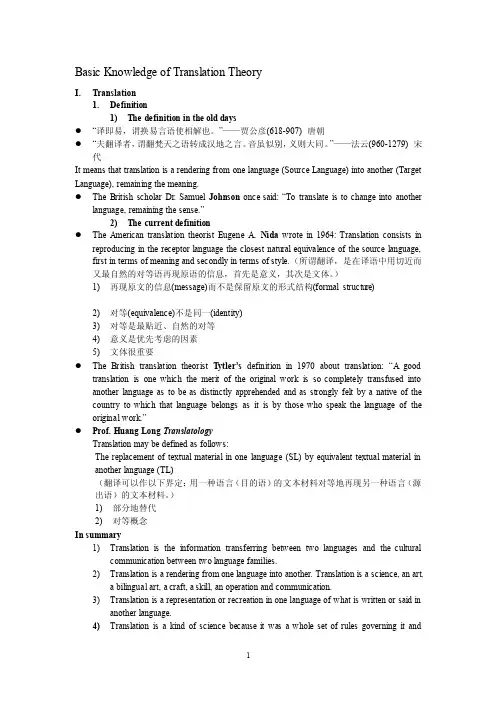
Basic Knowledge of Translation TheoryI.Translation1.Definition1)The definition in the old days●“译即易,谓换易言语使相解也。
”——贾公彦(618-907) 唐朝●“夫翻译者,谓翻梵天之语转成汉地之言。
音虽似别,义则大同。
”——法云(960-1279) 宋代It means that translation is a rendering from one language (Source Language) into another (Target Language), remaining the meaning.●The British scholar Dr. Samuel Johnson once said: “To translate is to change into anotherlanguage, remaining the sense.”2)The current definition●The American translation theorist Eugene A. Nida wrote in 1964: Translation consists inreproducing in the receptor language the closest natural equivalence of the source language, first in terms of meaning and secondly in terms of style.(所谓翻译,是在译语中用切近而又最自然的对等语再现原语的信息,首先是意义,其次是文体。
)1)再现原文的信息(message)而不是保留原文的形式结构(formal structure)2)对等(equivalence)不是同一(identity)3)对等是最贴近、自然的对等4)意义是优先考虑的因素5)文体很重要●The British translation theorist T ytler‟s definition in 1970 about translation: “A goodtranslation is one which the merit of the original work is so completely transfused into another language as to be as distinctly apprehended and as strongly felt by a native of the country to which that language belongs as it is by those who speak the language of the original work.”●Prof. Huang Long TranslatologyTranslation may be defined as follows:The replacement of textual material in one language (SL) by equivalent textual material in another language (TL)(翻译可以作以下界定:用一种语言(目的语)的文本材料对等地再现另一种语言(源出语)的文本材料。
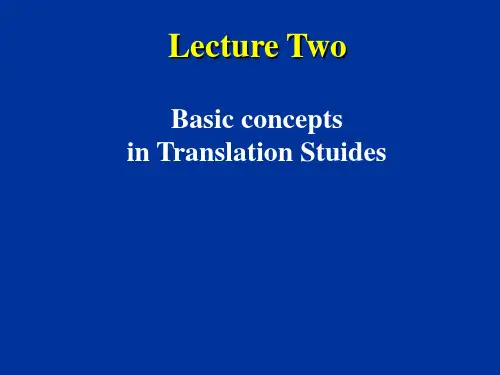

Translation-quality standardsLike any supplier of goods or services, a translator potentially bears ethical and legal obligations toward his patron or employer. This has turned to be of enormous importance with the development of the language industry at global scale. For the protection of both parties, standards have been developed that seek to spell out their mutual duties.HistoryStandards of quality and documentation were originally developed for manufacturing businesses. Codes for all types of services are now maintained by standardization organizations such as the International Organization for Standardization. Standards of this type include those of the ISO 9000 series.As interest in quality management has grown, specific quality standards have been developed for translation services. These have included the Italian UNI 10574, the German DIN 2345, the Austrian Önorm D 1200 and Önorm D 1201, and the Canadian CAN CGSB 131.10.In 2015, EN 15038 was replaced by ISO 17100:2015.[1]EN 15038The European EN 15038 translation-services standard went into effect on August 1, 2006,[2] replacing the previous standards of the 30 individual CEN member countries. It aims to unify the terminology used in the translation field, define basic requirements for language-service providers (human and technical resources, quality control, and project management) and create a framework for the interaction of customers and service providers in terms of their rights and obligations. It also defines certain services, in addition to translation, that may be offered by language-serviceproviders.[3]A strong focus is on administrative, documentation, review and revision processes, as well as on the functions of different specialists who guide the translation project over its duration. Appendices to the standard provide information and suggestions on how best to comply with the standard.CAN CGSB 131.10-2008On May 12, 2009, the Language Industry Association of Canada, AILIA launched the latest standards certification program in the world.[4] The certification is based on CAN/CGSB-131.10-2008, Translation Services, a national standard developed by the Canadian General Standards Board and approved by the Standards Council of Canada. It involved the participation of representatives from AILIA, professional associations, government, academia, purchasers of service, and other stakeholders.The Canadian Standard for Translation Services CAN CGSB 131.10 - 2008 establishes and defines the requirements for the provision of translation services by translation service providers.This National Standard of Canada is a modified adoption of the European Committee for Standardization (CEN) standard EN 15038 Translation Services. This document was prepared with the intent to harmonize where possible with the provisions of EN 15038 Translation Services. Variances in wording and content with EN 15038 reflect the Canadian perspective.Conformity assessment and certification based on this standard are already in place. With the recent development of national and regional standards for translation services, many translation service providers, nationally and internationally, are now in the process of either considering or seeking certification of the services they provide in meeting the demands of the marketplace.The standard specifies the requirements for the provision of translation services by the translation service provider (TSP).There are three key points common to all standards:Select your human resources with care.Come to an agreement on your project specifications before translation begins.Follow the specifications at every step of the project.The CGSB 131.10 discuss the following:ScopeDefinitionsHuman ResourcesTechnical ResourcesQuality Management SystemClient-TSP RelationshipTSP Project Management ProceduresTranslation ProcessNotesAppendixes:A. Project RecordingB. Pre-Translation ProcessingC. Additional ServicesThe standard does not apply to interpreting or terminology services.TSPs interested in getting certified can review the AILIA Certification Preparation GuideThe AILIA Translation Committee takes care of the promotion of the Canadian Translation Standard and its certification.ASTM F2575-06The American translation-services standard is the ASTM F2575-06 Standard Guide for Quality Assurance in Translation.[5] It provides a framework for customers and translation-service providers desirous of agreeing on the specific requirements of a translation project. It does not provide specific criteria for translation or project quality, as these requirements may be highly individual, but states parameters that should be considered before beginning a translation project. As the document's name suggests, it is a guideline, informing stakeholders about what basic quality requirements are in need of compliance, rather than a prescriptive set of detail instructions for the translator. Criticism: over-dependence on standardsThere is, however, a view within the translation industry that, while not doing any actual harm, an over-reliance on such standards can give a false sense of security. Blindly following translation standards does not on its own provide real assurance regarding translation quality. The argument is that the path to quality in translation is by focusing more on providing on-going training and feedback to translators.。
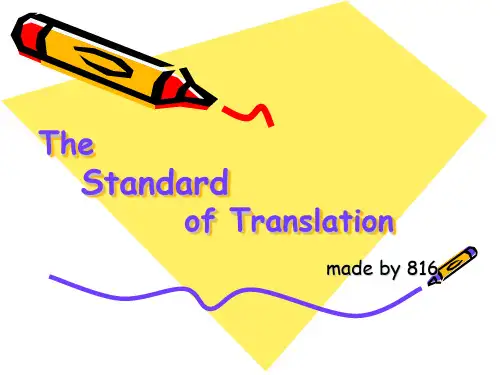
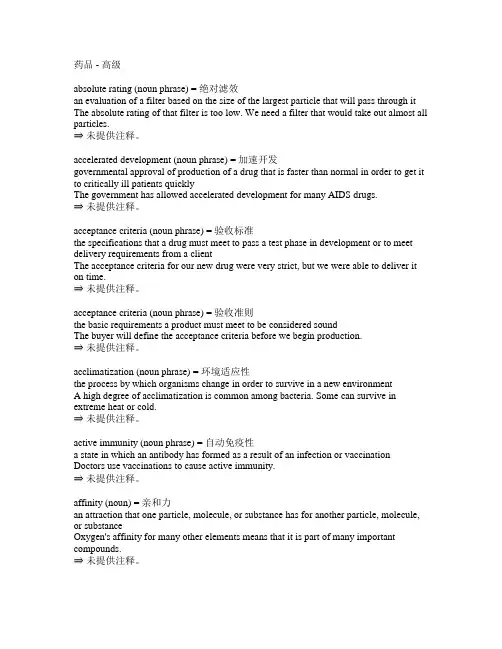
药品 - 高级absolute rating (noun phrase) = 绝对滤效an evaluation of a filter based on the size of the largest particle that will pass through it The absolute rating of that filter is too low. We need a filter that would take out almost all particles.⇒未提供注释。
accelerated development (noun phrase) = 加速开发governmental approval of production of a drug that is faster than normal in order to get it to critically ill patients quicklyThe government has allowed accelerated development for many AIDS drugs.⇒未提供注释。
acceptance criteria (noun phrase) = 验收标准the specifications that a drug must meet to pass a test phase in development or to meet delivery requirements from a clientThe acceptance criteria for our new drug were very strict, but we were able to deliver it on time.⇒未提供注释。
acceptance criteria (noun phrase) = 验收准则the basic requirements a product must meet to be considered soundThe buyer will define the acceptance criteria before we begin production.⇒未提供注释。
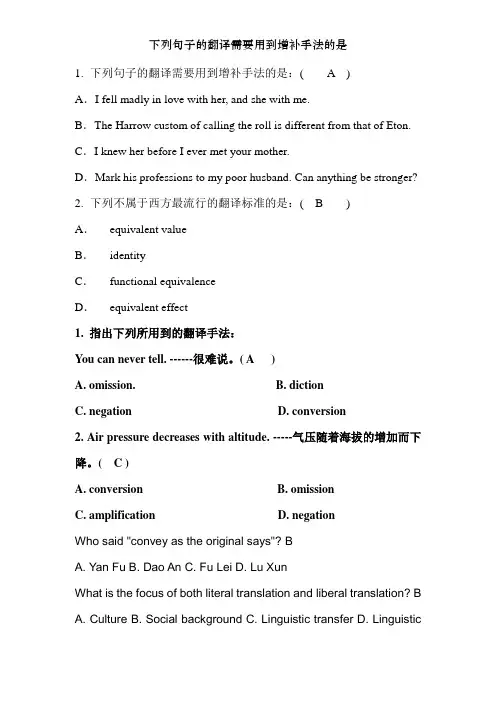
1.下列句子的翻译需要用到增补手法的是:( A )A.I fell madly in love with her, and she with me.B.The Harrow custom of calling the roll is different from that of Eton. C.I knew her before I ever met your mother.D.Mark his professions to my poor husband. Can anything be stronger?2.下列不属于西方最流行的翻译标准的是:( B ) A.equivalent valueB.identityC.functional equivalenceD.equivalent effect1. 指出下列所用到的翻译手法:You can never tell. ------很难说。
( A )A. omission.B. dictionC. negationD. conversion2. Air pressure decreases with altitude. -----气压随着海拔的增加而下降。
( C )A. conversionB. omissionC. amplificationD. negationWho said "convey as the original says"? BA. Yan FuB. Dao AnC. Fu LeiD. Lu XunWhat is the focus of both literal translation and liberal translation? B A. Culture B. Social background C. Linguistic transfer D. LinguisticenvironmentEnglish is a ___C__ language dominated by_____, whereas Chinese is a _____ language dominated by _____.A.semantic nouns morphological verbsB.semantic verbs morphological nounsC.morphological nouns semantic verbsD.morphological verbs semantic nounsEnglish syntactic features are the_B____, and English is_____ prominent language, but Chinese syntactic features are the_____.A.hypotaxis predicate parataxisB.hypotaxis subject parataxisC.parataxis subject hypotaxisD.parataxis predicate hypotaxisWhich is not one of devices of textual cohesion ? DA collocationB referenceC synonymyD ParataxisWhich is not one of the procedure of translation ? CA understandingB checkC lookingD expressionWhen translating long sentences, we should realize that the sentence structure of Chinese is---A--?A. bamboo-likeB. chain-likeC. circle-likeD. tree-like1 篇章是表达整体概念的—B—单位。
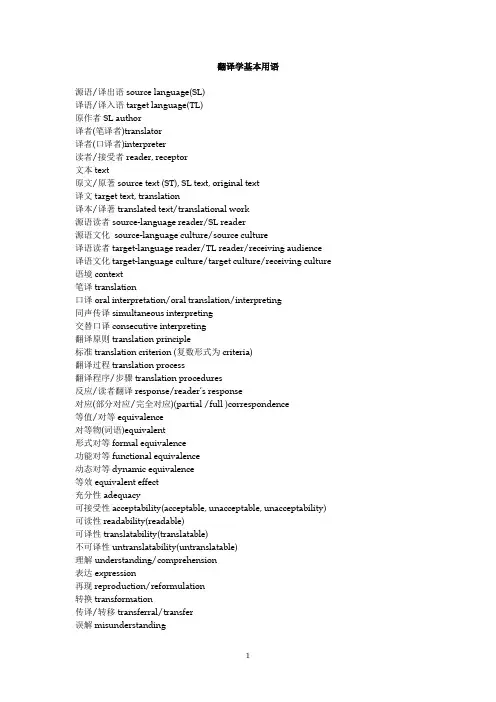
翻译学基本用语源语/译出语source language(SL)译语/译入语target language(TL)原作者SL author译者(笔译者)translator译者(口译者)interpreter读者/接受者reader, receptor文本text原文/原著source text (ST), SL text, original text译文target text, translation译本/译著translated text/translational work源语读者source-language reader/SL reader源语文化source-language culture/source culture译语读者target-language reader/TL reader/receiving audience 译语文化target-language culture/target culture/receiving culture 语境context笔译translation口译oral interpretation/oral translation/interpreting同声传译simultaneous interpreting交替口译consecutive interpreting翻译原则translation principle标准translation criterion (复数形式为criteria)翻译过程translation process翻译程序/步骤translation procedures反应/读者翻译response/reader’s response对应(部分对应/完全对应)(partial /full )correspondence等值/对等equivalence对等物(词语)equivalent形式对等formal equivalence功能对等functional equivalence动态对等dynamic equivalence等效equivalent effect充分性adequacy可接受性acceptability(acceptable, unacceptable, unacceptability) 可读性readability(readable)可译性translatability(translatable)不可译性untranslatability(untranslatable)理解understanding/comprehension表达expression再现reproduction/reformulation转换transformation传译/转移transferral/transfer误解misunderstanding误译mistranslation伪译pseudo-translation异化foreignizing /source-oriented translation归化domesticating/naturalization/target-accommodating translation 词汇空缺lexical gap文化沟(空缺/非对应)cultural gap直译literal translation/direct translation意译free translation/liberal translation/semantic translation重复法repetition增译法/增词法/增译amplification/addition减译法/减词法/省略法/省译omission词类转移法/词性转换conversion反译法/正反译法/反正译法negation移植法transplant(ing)/transplantation音译法transliteration具体化specification概括化generalization抽象化abstracting明析化explicitation译借(语义转借)calque(loan translation)加注法annotation夹注intratextual note脚注footnote尾注/文后注endnote注释性翻译annotated/commented translation释义法/解释法explanation/paraphrase引申法extension替代法substitution/replacement借用borrowing推演法deduction缀合法combination分译法division逆序法/倒置法reversing合译法combination综合法mixture of methods包孕embedding切断/分切cutting拆离splitting-off插入inserting重组recasting回译back translation还原法finding the original原汁原味essence of the original, original flavor词序调整inversion选词diction补偿compensation视点转换shift of perspective套译/仿译/仿拟imitation信/忠实faithfulness/fidelity达/易懂intelligibility/expressiveness通顺smoothness流畅fluency自然naturalness /idiomaticity雅/优美elegance/gracefulness简洁brevity明析clarity简明conciseness内涵connotation含义implication言外之意allocution本文意义(文本固有之意)inherent meaning (of the text)译者隐形translator’s invisibility透明(度)transparency宁信而不顺(鲁迅语) rather to be faithful than smooth (“I’d rather be faithful than smooth”)神似(傅雷语) spiritual resemblance化境(钱钟书语)sublimation/transmigration of souls信、达、雅(严复语)faithfulness, expressiveness and elegance三美: 音美,形美,意美(许渊冲语)the three beauties: beauty in sound, beauty in form and beauty in meaning东方语言Oriental languages西方语言Occidental languages佛经Buddhist Scriptures/sutra梵语Sanskrit鸠摩罗什Kumarajiva泰特勒(Alexander Fraser )Tytler奈达(Eugene A.) Nida机器翻译machine translation(MT)人工智能artificial intelligence(AI)翻译translate, render, rephrase, reword, transmit, re-express, transmute, transmogrify, interpret, convert, transform, transpose, express, transfer, turn翻译学translatology/Translation Studies翻译体/翻译腔translationese死译/硬译mechanical translation逐字译word-for-word translation/word-to-word substitution/verbatim translation乱译/胡译excessively- free translation歪译(意义扭曲)distortion惯用法usage搭配collocation约定俗成convention 形合hypotaxis意合parataxis动态dymanic静态stative。

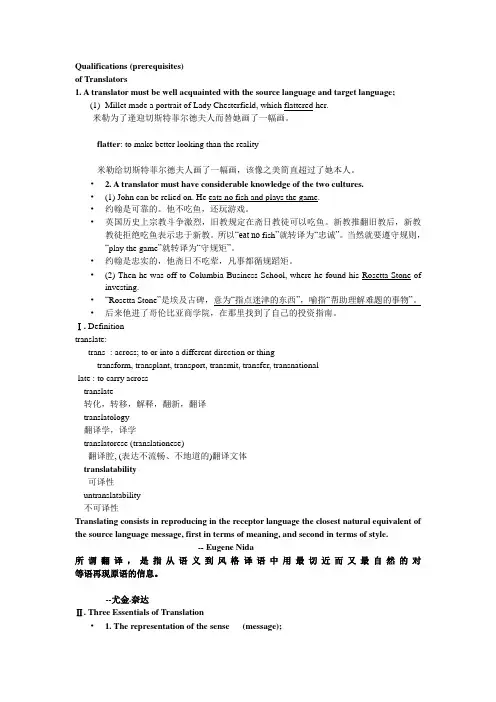
Qualifications (prerequisites)of Translators1. A translator must be well acquainted with the source language and target language;(1)Millet made a portrait of Lady Chesterfield, which flattered her.米勒为了逢迎切斯特菲尔德夫人而替她画了一幅画。
flatter: to make better looking than the reality米勒给切斯特菲尔德夫人画了一幅画,该像之美简直超过了她本人。
• 2. A translator must have considerable knowledge of the two cultures.•(1) John can be relied on. He eats no fish and plays the game.•约翰是可靠的。
他不吃鱼,还玩游戏。
•英国历史上宗教斗争激烈,旧教规定在斋日教徒可以吃鱼。
新教推翻旧教后,新教教徒拒绝吃鱼表示忠于新教。
所以“eat no fish”就转译为“忠诚”。
当然就要遵守规则,“play the game”就转译为“守规矩”。
•约翰是忠实的,他斋日不吃荤,凡事都循规蹈矩。
•(2) Then he was off to Columbia Business School, where he found his Rosetta Stone of investing.•“Rosetta Stone”是埃及古碑,意为“指点迷津的东西”,喻指“帮助理解难题的事物”。
•后来他进了哥伦比亚商学院,在那里找到了自己的投资指南。
Ⅰ. Definitiontranslate:trans- : across; to or into a different direction or thingtransform, transplant, transport, transmit, transfer, transnational-late : to carry acrosstranslate转化,转移,解释,翻新,翻译translatology翻译学,译学translatorese (translationese)翻译腔, (表达不流畅、不地道的)翻译文体translatability可译性untranslatability不可译性Translating consists in reproducing in the receptor language the closest natural equivalent of the source language message, first in terms of meaning, and second in terms of style.-- Eugene Nida所谓翻译,是指从语义到风格译语中用最切近而又最自然的对等语再现原语的信息。
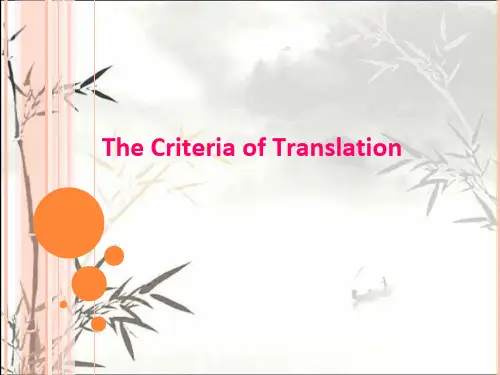
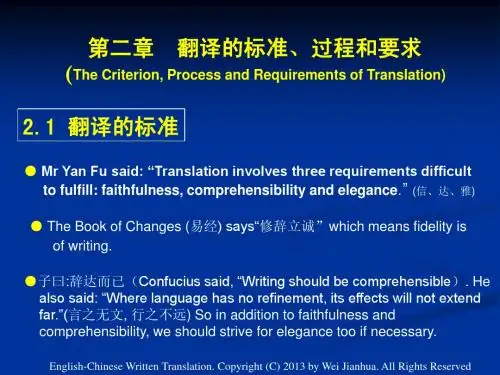
翻译学基本用语源语/译出语source language(SL), original language译语/译入语target language(TL), receptor language, receiving language原作者SL author, original author译者(笔译者)translator译者(口译者)interpreter读者/接受者reader, receptor, audience文本text原文/原著source text (ST), SL text, original text, original version/original work 译文target text, translation, target version, rendering, rendition译本/译著translated text/translational work源语读者source-language reader/SL reader源语文化source-language culture/source culture译语读者target-language reader/TL reader/receiving audience译语文化target-language culture/target culture/receiving culture语境context笔译written translation口译oral interpretation/oral translation/interpreting同声传译simultaneous interpreting交替口译consecutive interpreting翻译原则translation principle标准translation criterion (复数形式为criteria)翻译过程translation process翻译程序/步骤translation procedures反应/读者翻译response/reader’s response对应(部分对应/完全对应)(partial /full )correspondence等值/对等equivalence对等物(词语)equivalent形式对等formal equivalence功能对等functional equivalence动态对等dynamic equivalence等效equivalent effect充分性adequacy可接受性acceptability(acceptable, unacceptable, unacceptability)可读性readability(readable)可译性translatability(translatable)不可译性untranslatability(untranslatable)表层结构surface structure深层结构deep structure理解understanding/comprehension表达expression再现reproduction/representation转换transformation传译/转移transferral/transfer误解misunderstanding误译mis-translation异化foreignization/alienation/exoticization/ exogenization/source-oriented translation归化domestication/naturalization/adaptation/endogenization/target-accommodating translation 词汇空缺lexical gap文化沟(空缺/非对应)cultural gap直译literal translation/direct translation意译free translation/liberal translation/semantic translation直译派a literalist/a sourcerer意译派a free-hander/a targeteer重复法repetition增译法/增词法/增译amplification/addition减译法/减词法/省略法/省译omission词类转移法/词性转换conversion反译法/正反译法/反正译法negation移植法transplant(ing)/transplantation音译法transliteration具体化specification 概括化generalization 抽象化abstracting明析化explicitation译借(语义转借)calque(loan translation)加注法annotation夹注intratextual note 脚注footnote尾注/文后注endnote注释性翻译annotated/commented translation释义法/解释法explanation/paraphrase引申法extension替代法substitution/replacement借用borrowing推演法deduction缀合法combination分译法division逆序法/倒置法reversing合译法combination综合法mixture of methods包孕embedding切断/分切cutting拆离splitting-off插入inserting重组recasting回译back translation还原法finding out the original原汁原味essence of the original, original flavor词序调整inversion选词diction补偿compensation视点转换shift of perspective套译/仿译/仿拟imitation信/忠实faithfulness/fidelity达/易懂intelligibility/expressiveness通顺smoothness流畅fluency自然naturalness /idiomaticity雅/优美elegance/gracefulness简洁brevity明析clarity简明conciseness内涵connotation含义implication言外之意allocution本文意义(文本固有之意)inherent meaning (of the text)译者隐形translator’s invisibility透明(度)transparency宁信而不顺(鲁迅语)rather to be faithful than smooth (“I’d rather be faithful than smooth”)神似(傅雷语) spiritual resemblance化境(钱钟书语)sublimation信、达、切(刘重德语)faithfulness, expressiveness and closeness (to the original style)三美: 音美,形美,意美(许渊冲语)the three beauties: beauty in sound, beauty in form and beauty in meaning东方语言Oriental languages西方语言Occidental languages佛经Buddhist Scriptures/sutra梵语Sanskrit鸠摩罗什Kumarajiva泰特勒(Alexander Fraser )Tytler 奈达(Eugene A.) Nida机器翻译machine translation(MT) 人工智能artificial intelligence(AI)翻译translate, render, rephrase, reword, transmit, re-express, transmute, transmogrify, interpret, convert, transform, transpose, express, transfer, turn翻译学translatology/Translation Studies翻译体/翻译腔translationese死译/硬译mechanical translation逐字译word-for-word translation/word-to-word substitution/verbatim translation乱译/胡译excessively free translation歪译(意义扭曲)distortion惯用法usage搭配collocation约定俗成convention形合hypotaxis 意合parataxis。
1.1 严复的“信、达、雅” 关于“信”,严复认为:译文应该抓住全文要旨,对于词句可以有所颠倒增删,只要不失原意,不必斤斤计较词句的对应和顺序。
关于“达”,严复认为:达非常重要。
只信而不达,译了等于没译;只有做到达,才能做到信。
要做到达,译者必须首先认真通读全文,做到融会贯通,然后进行翻译。
为了表达原意,可以在词句方面作必要的调整改动。
关于“雅” ,严复认为:译文要雅,否则没有人看。
“雅” 是指“古雅” ,要采用汉代以前使用的古文。
对于严复的信达雅,不少人对于“雅” 有一些不同的看法:不能脱离原文,片面求雅;如果原文不雅,译文怎么能雅?况且,严复主张的是古雅,即用古文进行翻译,这是不可取的。
至于“信” 和“达” ,多年来用作评价翻译的尺度,在我国翻译界一直是没有异议的。
严复在《天演论·译例言》里首次提出了“信、达、雅” 的翻译标准。
“信” 指的是“忠实” ,“达” 指的是“流畅” ,“雅” 指的是“尔雅”。
所谓“尔雅”, 用严复自己的话来说就是“用汉以前字法、句法”。
一百年来,严复提出的“信、达、雅” 在中国翻译界起了很大的作用。
人们对“信” 和“达” 没有什么争论, 唯有“雅”字例外。
再“用汉以前字法、句法” 进行翻译是不行了。
因此人们对“雅” 字作过各种解释,发过各种议论。
纵观各家之言,我认为周照良教授的解释是比较可取的。
周照良教授在“翻译三论” 一文中说:“我认为应当作为‘得体'来理解。
得体不仅仅指文笔,而是指文笔基本上必须根据内容来定;文笔必须具有与其内容相适应的风格。
”他还说:“信、达、雅”三者哪一个最重要?我以为要看内容而定。
如果译的是《读者文摘》或旅游见闻,那就要着重达,便是漏译一两句也无关宏旨。
如果译的是哲学、社会科学, 特别是经典著作, 信就应当放在首位。
... 至于文学翻译, 那当然要讲究文笔。
如果一篇译文在内容上是忠实的,在语言上是通顺的,在风格上是得体的,那的确就是一篇很好的译文了。
环保术语的英汉翻译发布人:圣才学习网发布日期:2010-08-20 16:53 共17人浏览[大] [中] [小] [摘要] 目前,国际社会对环境保护问题的重视程度不断提高,我国也是如此。
在同国际接轨的过程中,我们必然涉及对大量环保词汇的引进及其翻译问题。
为此,笔者查找了大量资料,将各领域的主要环保词汇及其现有中文译名进行了归纳和整理,希望能对今后的相关翻译工作有所帮助。
[关键词] 环保术语中文译名1 概述随着当今世界经济的迅猛发展和全球经济一体化进程的不断推进,可持续发展问题已同和平问题并列为世界两大主题,备受关注。
而环境保护问题,作为可持续发展中很重要的一项,正渗透到人们社会生活中的各个方面,成为不单是环保工作者而且是全人类共同关注的大事。
我国在这一领域起步相对较晚,有许多须借鉴西方之处。
正是这一过程,涉及到大量环保词汇的引进和翻译一事。
如果没有准确、易解的译名,我们的环保事业和日常宣传将面临许多麻烦和误区。
目前,国内相关的词典和文章较少且零散,给翻译工作带来种种不便。
为此,笔者寻找了大量资料,整理出部分较集中并已经认可的环保术语及其中文译名,在此加以归类,希望能对今后的相关翻译工作有所帮助。
以下,笔者将从环境科学、工农业生产环保、日常生活环保和环保法律法规等方面对其分别进行介绍。
2 环境科学方面环境科学是一门精密而广博的学科。
由于环境保护这一课题的特殊性,它对大千世界的各类物质从环保的角度出发进行了严格定义,主要分有:returnable or recyclable(可回收利用的),disposable(一次性的或不可回收利用的),explosive(爆炸性的),reactive(易起化学反应的)等。
在能源方面,又分为renewable or nonrenewable energy sources (可再生和不可再生能源),non-polluting or polluting energy sources(无污染和污染性能源)。
翻译研究词语 1.表情功能expressive function 2.词类转换conversion of word classes 3.词义空缺semantic zero 4.词义相符semantic correspondence 5.词义相异semantic non-correspondence 6词语层面word level 7达expressiveness 8段落层面paragraph level 9对应correspondence 10 翻译,笔译translation 11翻译标准translation criteria 12翻译策略translation strategy 13翻译腔translationese 14翻译学translation studies/translatology 15翻译原则principles of translation 16分析性analytic 17符际翻译intersemiotic translation 18惯用法意识sense of good usage 19归化domestication 20含义implicature/implied meaning 21呼唤功能vocative function 22化境sublimation 23话语discourse 24回指anaphoric 25加注法annotation 26减省法omission 27句法syntax 28句子层面sentence level 29科技文本text of science and technology 30可读性readability 31可译性translatability 32口译interpretation/interpreting 33口译译员interpreter 34跨文化交际cross-cultural communication 35连贯coherence 36连贯意识sense of coherence 37逻辑思维logical thinking 38美感功能aesthetic function 39目的性intentionality 40内指endophoric 41篇章层面discourse level 42情景语境context of situation 43认知功能cognitive function 44上下文co-text 45社会学符号sociosemiotics 46神似similarity in spirit47省略ellipsis 48释义法paraphrase 49述位rheme 50 体裁genre 51外指exophoric 52文本/语篇text 53文本类型text type 54 文化语境context of culture 55文化意识sense of culture 56文体/风格style 57衔接cohesion 58衔接结cohesive tie 59显性overtness 60校核proofreading 61信faithfulness/fidelity 62信息功能informative function 63形合hypotaxis 64形似similarity in form 65形象思维figurative thinking 66修辞层面rhetorical level 67雅elegance 68异化foreignization /alienation 69译文target text 70译文读者target-text readers 71译者translator 72意合parataxis 73意境ideorealm 74意译liberal translation 75音译transliteration 76隐性covertness 77语法意识sense of grammar 78语际翻译interlingual translation 79语境context 80语内翻译intralingual translation 81语文学philology 82语言学linguistics 83语义学semantics 84语音层面phonetic level 85语用学pragmatics 86语域register 87翻译语言的功能metalingual function88原文sourcetext/original text 89原文读者source-text readers90蕴含意义connotation91増词amplification/addition 92照应anaphora 93直译literal translation 94指称意义denotation 95主体性subjectivity 96主位theme 97转换transformation/transfer98综合性synthetic 99作者writer/author中国文化特色词语英译1.拜年pay a New Yearcall 2.财运luck inmaking money 3.禅宗Chan Sect/Zen Sect 4.出家人ascetic 5.祠堂memorial temple 6.倒春寒an unusually cold spellin an otherwise warmearly spring 7.道教Taoism 8.道士Taoistpriest 9.法师Master 10.方丈Buddhist abbot 11.佛教Buddhism 12.恭喜发财May you beprosperous!/Wish you allthe best! 13.和尚Buddhist monk 14.红包red envelope containingmoney as a gift;(贬义用法)bribe/kickback 15.红运good luck 16.华表ornamental column/cloudpillar/stele 17.华盖canopy 18.回教Islam 19.慧根the organ of wisdom20.基督教Christianity 21.甲骨文inscriptions onoracle bones 22.江南水乡the south of the lowerreaches of the Y angtzeRiver 23.戒precept/discipline 24.金刚经Diamond Sutra 25.京剧票友Peking Operafan 26.京剧人物脸谱types of facial make-up inPeking Opera 27.景泰蓝cloisonné28.旧教/天主教Catholicism 29.坎儿井karez 30.空emptiness31.喇嘛Lama 32.老字号an old and famousshop/enterprise 33.尼姑Buddhist nun 34.涅槃Nirvana 35.旗袍cheongsam 36.三藏经Triptaka 37.三教(儒、释、道)Confucianism,Buddhism and Taoism 38.时运luck/fortune 39.四大皆空all spacedirections being valid 40.新教,耶稣教Protestantism 41.真人Taoist pure man 42.族人clansman 43.坐禅sittingin meditation节假日 1.春节SpringFestival 2.党的生日Party’s Birthday 3.端午节Dragon-Boat Festival4.国庆节National Day5.建军节Army Day 6.教师节Teachers’Day 7.清明节Pure Brightness Day 8.国际儿童节InternationalChildren’s Day 9.三八妇女节InternationalWorking Women’s Day10.五一InternationalLabor Day 11.元旦NewYear’s Day 12.元宵节Lantern Festival 13.中秋节Mid-Autumn Festival14.重阳节Double-NinthFestival政治经济活动1遵纪守法to observe disciplineand abide by the law 2.走共同致富的道路to takethe road to commonprosperity 3.自留地individual farm plots 4自负盈亏to be responsiblefor one’s own profit andloss 5专业户specializedhousehold 6重复建设tobuild redundant project 7治理整顿to improve theeconomic environmentand rectify the economicorder 8治理三乱to put toa stop/eliminateindiscriminate fines,charges and levies 9政企分开to separategovernment functionsfrom enterprisemanagement 10宰人rip-off 11有经济头脑的人commercially mindedpeople 12优生优育topromote good prenataland postnatal care 13以权谋私to abuse powerfor personal gains 14移风易俗to transformoutmoded habit andcustom 15依法治国torule the country inaccordance with law 16一切向钱看money-mania 17一国两制one country,twosystems 18一刀切sweeping approach 19严防死守life-and-deathdefense 20严打to crackdown on crimes andsocial evils 21亚运村Asian Games Village 22姓社姓资问题distinctionof what is socialism andwhat is capitalism 23 星火计划Spark Program24信息高速公路information highway 25小商品市场smalls fair26小康生活to lead arelatively comfortable life27乡镇企业townshipenterprise 28下硬功夫to make intensive efforts29下海to take the plungeinto private business 30下岗人员the laid-off 31物质文明materialprogress 32五讲四美运动the movement of “fivestresses and four points ofbeauty”:to promotecivility,courtesy,tidiness,orderliness andintegrity 33五讲四美三热爱five stresses,fourpoints of beauty and threeaspects of love 34五好家庭five-virtue family 35温饱问题the problem ofinadequate food andclothing 36晚婚晚育late marriage andpostponement ofchildbearing 37歪风邪气unhealthy practices andevil phenomena 38脱贫to shake off poverty 39退居二线to leave theleading post 40四有公民citizens who have highideals,moral integrity,a good education and astrong sense of discipline41十年规划和“八五”计划纲要the guidelinesof the Ten-YearProgramme and theEighth Five-Year Plan 42十年动乱the ten chaoticyears 43涉外婚姻Chinese marriage withforeign nationals 44扫黄anti-pornography drive45三资企业enterprisesin the “three forms ofventures”:Sino-foreignjoint ventures,cooperative businessesand exclusivelyforeign-ownedenterprises 46三峡工程Three Gorges Straits 47三通three direct links oftrade,mail and air andshipping services acrossthe Taiwan Straits 48三角债debt chains 49权力下放to delegate 50全民所有制public ownership51勤俭建国to build thecountry with industry andthrift 52农转非agricultural people to begiven non-agriculturalstatus 53南水北调工程projects to divert waterfrom the south to thenorth 54 磨洋工todawdle along 55民工out-of-town laborer 56乱涨价unauthorized pricerise 57 乱摊派indiscriminate levies 58龙头to play a leadingrole in 59 领导班子leading body 60廉政建设construction of aclean government 61 亏损企业enterprisesrunning in the red 62跨世纪工程a trans-centuryproject 63可持续发展sustainable development64科教兴国战略thestrategy of developing thecountry by relying onscience and education 65科技是第一生产力Science and technologyconstitute a primaryproductive force 66康居工程the AffordableHousing Project 67开展扫黄打非斗争to crackdown on pornographyand other illegalpublications 68军转民military conversion 69九年义务教育nine-yearcompulsory education 70纠正不正之风to rectifyunhealthy tendencies andmalpractices 71纠风办State Council Office forRectification 72精神文明建设to promotecultural and ethicalprogress 73精简机构tostreamline governmentorgans 74经济特区special economic zone 75经济开发区economicdevelopment zone 76戒急用忍to overcomeimpetuosity and exercisepatience 77解放生产力to emancipate theproductive forces 78讲学习,讲政治,讲正气的党性党风教育toeducate the cadres in theParty spirit and stylethrough the promotion ofthe three emphases ontheoretical studies,political awareness andintegrity 79讲文明礼貌to promote civilizedbehavior 80减员增效,下岗分流to cut downthe size of workforce forefficiency and get thelayoffs re-employedelsewhere 81坚持两个文明一起抓to ensure thatefforts are made to builda society that is advancedboth materially andculturally andideologically 82假日经济holiday economy 83计划生育familyplanning 84集体主义community spirit 85基本国情fundamentalrealities of the country 86火炬计划Torch Program(a plan to develop newand high technology)87灰色收入income frommoonlighting 88户主head of a household 89户口管理制度domicilesystem 90户口簿residence booklet 91红筹股red-chip shares;redchips 92黑社会Mafia-styleorganizations;gangland93黑店gangster inn 94黑客hacker 95和平演变peaceful evolutiontowards capitalism 96和平统一,一国两制的方针the policy of peacefulreunification and theprinciple of “onecountry,two systems”97和平共处五项原则the Five Principles ofPeaceful Coexistence 98国有大中型企业largeand medium-sizedstate-owned enterprises99长期国库券treasurybonds 100官倒officialprofiteering 101挂靠tobe attached or affiliatedto 102公款吃喝banquetat public expense 103公费医疗medical servicesat state expense 104 革命老根据地the oldrevolutionary base areas105搞活经济toinvigorate the economy106 搞活国营大中型企业to invigorate largeand medium-sizedstate-owned enterprises107 高新技术产业开发区high and newtechnological industrydevelopment zone 108港人治港Hong Kongpeople governing HongKong 109改革开放reform and opening to theoutside world 110改革开放政策the reform andopen policy 111福利分房welfare-orientedpublic housingdistribution system 112扶贫poverty alleviation113房管real estatemanagement 114防洪工程flood-preventionproject 115发展是硬道理Development is ofoverriding importance116第三产业tertiaryindustry 117第二职业second employment 118倒爷profiteer 119党性one’s Party morale 120党群关系Party-massesrelationship 121待业job-waiting 122大腕topnotch(singer etc.)123大排档sidewalk snackbooth 124大路货staplegoods 125打破僵局tobreak the deadlock 126打假to crack down oncounterfeit goods 127打白条to issue IOUs 128磁悬浮列车magneticsuspension 129春运(passenger)transportation during theSpring Festival 130传销pyramid selling 131吃皇粮to receive salaries,subsidies,or othersupported from thegovernment 132吃大锅饭the egalitarian practiceof“everybody eating fromthe same big pot”133超计划生育to have morechildren than what isplanned 134参政议政意识the awareness of theneed to participate in thediscussion andadministration of stateaffairs 135菜篮子工程the shopping basketproject 136部优产品Ministry-recognizedquality goods 137不正之风unhealthy practice(tendency)138不良风气unhealthy ways andcustoms 139不合理收费,集资和摊牌toimpose charges andquotas and collect moneywithout authorization 140不顾条件,一哄而起torush into action indisregard of objectiveconditions 141拨乱反正to set things right 142 变相涨价disguisedinflation 143本位主义departmentalism 144保重点,不撒胡椒面Resources must bechanneled to priorityprojects and not spreadthinly everywhere 145包干到户work contractedto households 146半拉子工程uncompleted project147摆门面to put up animpressive front 148百年不遇once-in-a-century149百花齐放,百家争鸣Let a hundred flowersblossom and a hundredschools of thoughtcontend 150把已经确定的方针政策措施落到实处to get the setprinciples,policies andmeasures implemented151把眼光放远一些tohave a broad view 152把握正确的舆论导向toproperly guide the publicopinion 153按劳分配distribution according toone’s performance 154安居工程HousingProject for low-incomefamilies 155“一条龙”服务coordinated-processservice 156“豆腐渣”工程jerry-built project 157“达标”活动“targethitting”activities节气1大寒Greater Cold2小寒Lesser Cold 3冬至the Winter Solstice 4大雪Greater Snow 5小雪Lesser Snow 6立冬theBeginning of Winter 7霜降Frost’s Descent 8秋分the Autumnal Equinox9白露White Dew 10处暑the Limit of Heat 11立秋the Beginning ofAutumn 12大暑GreatHeat 13小暑Slight Heat14夏至the SummerSolstice 15芒种Grain inEar 16小满Grain Full 17立夏the Beginning ofSummer 18谷雨GrainRain 19清明PureBrightness 20春分theSpring Equinox 21惊蛰the Waking of Insects 22雨水Rain Water 23立春the Beginning of Spring24寒露Cold Dew 25二十四节气thetwenty-four solar terms。
criteria翻译
标准(Criteria)是一种标准,可以用来衡量一件事物或行为的质量。
标准是为了避免事物的混乱,以及确保任务的正确性、完成度和安全性。
标准也被称为质量标准、安全标准和制度标准。
标准是一种指导,通常用于提高工作效率和质量。
它通常由行业中的专家和专业机构制定,以确保某项工作的一致性、准确性和可靠性。
标准通常被认为是防止无谓的错误和损失的最佳方式。
标准能够促进企业发展。
它们可以提高企业的有效性和效率,确保企业提供的产品或服务符合市场标准。
它还能够确保企业的行为符合法规和行业道德准则,以确保企业的长期可持续发展。
在国际交流和贸易领域,标准能够维护买卖双方的利益。
它可以确保买卖双方在履行商业合同时,双方产品和服务的质量都得到满足。
此外,标准还有助于减少在两种不同国家之间可能出现的争端。
在企业经营及管理领域,标准是企业的基础。
它们可以帮助企业有效管理由产品和服务构成的流程,以确保所有环节都按照规定进行。
此外,标准也有助于确保企业的安全和环境友好。
因此,可以说,标准对于确保一切正常运行至关重要。
标准有助于确保任务的准确性、完整性和安全性,使企业能够有效地经营,促进企业发展和可持续发展,同时确保双方利益的均衡。
- 1 -。